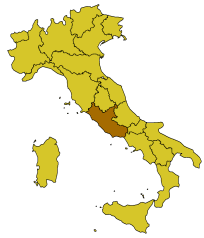
A Chianti wine is any wine produced in the Chianti region of central Tuscany. It was historically associated with a squat bottle enclosed in a straw basket, called a fiasco. However, the fiasco is only used by a few makers of the wine as most Chianti is now bottled in more standard shaped wine bottles. In the mid-late 19th century, Baron Bettino Ricasoli helped establish Sangiovese as the blend's dominant grape variety, creating the blueprint for today's Chianti wines.

Sangiovese is a red Italian wine grape variety that derives its name from the Latin sanguis Jovis, "the blood of Jupiter". Though it is the grape of most of central Italy from Romagna down to Lazio, Campania and Sicily, outside Italy it is most famous as the only component of Brunello di Montalcino and Rosso di Montalcino and the main component of the blends Chianti, Carmignano, Vino Nobile di Montepulciano and Morellino di Scansano, although it can also be used to make varietal wines such as Sangiovese di Romagna and the modern "Super Tuscan" wines like Tignanello.

Italian wine is produced in every region of Italy. Italy is the world's largest producer of wine, with an area of 702,000 hectares under vineyard cultivation, and contributing a 2013–2017 annual average of 48.3 million hl of wine. In 2018 Italy accounted for 19 per cent of global production, ahead of France and Spain. Italian wine is both exported around the world and popular domestically among Italians, who consume an average of 42 litres per capita, ranking fifth in world wine consumption.
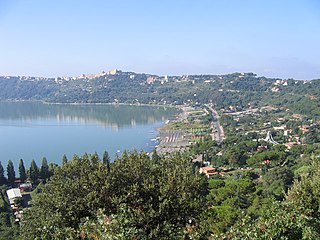
The so-called Roman Castles are a group of comunes in the Metropolitan City of Rome. They are located a short distance south-east of the city of Rome, at the feet of the Alban Hills, in the territory corresponding to the Old Latium.
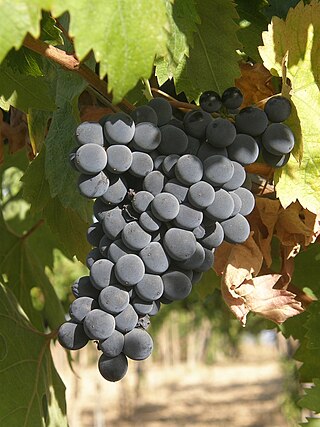
Montepulciano d'Abruzzo is an Italian red wine made from the Montepulciano wine grape in the Abruzzo region of east-central Italy. It should not be confused with Vino Nobile di Montepulciano, a Tuscan wine made from Sangiovese and other grapes.

Lizzano is a comune of 10,175 inhabitants (2013) in the province of Taranto in the Apulia region of southeast Italy.

Torgiano is a comune (municipality) in the Province of Perugia in the Italian region Umbria, located about 10 km southeast of Perugia.

Olevano Romano is a comune (municipality) in the Metropolitan City of Rome in the Italian region of Latium, located about 45 kilometres (28 mi) east of Rome.
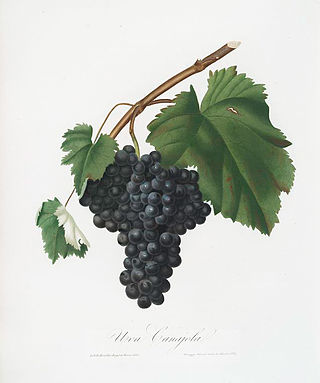
Canaiolo is a red Italian wine grape grown through Central Italy but is most noted in Tuscany. Other regions with plantings of Canaiolo include Lazio, Marche and Sardegna. In Umbria a white berried mutation known as Canaiolo bianco exists. Together with Sangiovese and Colorino it is often used to create Chianti wine and is an important but secondary component of Vino Nobile di Montepulciano. In the history of Chianti it has been a key component blend and during the 18th century may have been the primarily grape used in higher percentage than Sangiovese. Part of its popularity may have been the grape's ability to partially dry out without rotting for use in the governo method of prolonging fermentation. In the 19th century, the Chianti recipe of Bettino Ricasoli called for Canaiolo to play a supporting role to Sangiovese, adding fruitiness and softening tannins without detracting from the wine's aromas. In the aftermath of the phylloxera epidemic, the Canaiolo vines did not take well to grafting onto new American rootstock and the grape began to steadily fall out of favor. As of 2006, total plantings of Canaiolo throughout Italy dropped to under 7,410 acres. Today there are renewed efforts by Tuscan winemakers to find better clonal selections and re-introduce the variety into popular usage.

Montepulciano is a red Italian wine grape variety that is most noted for being the primary grape behind the DOCG wines Offida Rosso, Montepulciano d'Abruzzo, Montepulciano d'Abruzzo Colline Teramane, Rosso Conero and the DOC wine Rosso Piceno Superiore.

Tuscan wine is Italian wine from the Tuscany region. Located in central Italy along the Tyrrhenian coast, Tuscany is home to some of the world's most notable wine regions. Chianti, Brunello di Montalcino and Vino Nobile di Montepulciano are primarily made with Sangiovese grape whereas the Vernaccia grape is the basis of the white Vernaccia di San Gimignano. Tuscany is also known for the dessert wine Vin Santo, made from a variety of the region's grapes. Tuscany has forty-one Denominazioni di origine controllata (DOC) and eleven Denominazioni di Origine Controllata e Garantita (DOCG). In the 1970s a new class of wines known in the trade as "Super Tuscans" emerged. These wines were made outside DOC/DOCG regulations but were considered of high quality and commanded high prices. Many of these wines became cult wines. In the reformation of the Italian classification system many of the original Super Tuscans now qualify as DOC or DOCG wines but some producers still prefer the declassified rankings or to use the Indicazione Geografica Tipica (IGT) classification of Toscana. Tuscany has six sub-categories of IGT wines today.

Calabrian wine is Italian wine from the Calabria region of southern Italy. Over 90% of the region's wine production is red wine, with a large portion made from the Gaglioppo grape. Calabria has 12 Denominazione di origine controllata (DOC) regions, but only 4% of the yearly production is classified as DOC wine. The region is one of Italy's most rural and least industrialized with per capita income less than half of the national average. Following World War II, many of Calabria's inhabitants emigrated to Northern Italy, the United States, Australia and Argentina. Those left behind have been slow to develop a vibrant wine industry with only the red wines of Cirò garnering much international attention. Today Calabrian wines are mostly produced to high alcohol levels and sold to co-operatives who transfer the wines to the northern Italian wine regions to use as blending component. There are no Denominazione di Origine Controllata e Garantita (DOCG) regions, but Calabria does have 12 Indicazione Geografica Tipica (IGT) designations.

Orvieto is an Italian wine region located in Umbria and Lazio, centered on the comune of Orvieto. It is primarily known for its white wines made from a blend of mostly Grechetto and Trebbiano, which is sold under the Denominazione di origine controllata (DOC) Orvieto and Orvieto Classico. Blended red wine and eight varietal reds are sold under the Rosso Orvietano DOC. The region has been producing wine since the Middle Ages, when Orvieto wine was known as a sweet, golden-yellow wine. Today's white Orvieto is dry, but a semi-sweet style, known as Orvieto Abboccato, and dolce (sweet), are also produced in small quantities.

Bombino bianco is a white Italian wine grape variety planted primarily along Italy's Adriatic coast line, most notably in Apulia. The vine is prone to high yields and often produces neutral flavor wines. The grape is known under many synonyms throughout Italy including Debit and Pagadebit, names which came from the grape's reputation for being a high yielding and reliable crop for vineyard owners to grow that would assure them that on each vintage they could pay off their debts.

The history of Chianti dates back to at least the 13th century with the earliest incarnations of Chianti as a white wine. Today this Tuscan wine is one of Italy's most well known and recognizable wines. In the Middle Ages, the villages of Gaiole, Castellina and Radda located near Florence formed as a Lega del Chianti creating an area that would become the spiritual and historical "heart" of the Chianti region and today is located within the Chianti Classico Denominazione di Origine Controllata e Garantita (DOCG). As the wines of Chianti grew in popularity other villages in Tuscany wanted their lands to be called Chianti. The boundaries of the region have seen many expansions and sub-divisions over the centuries. The variable terroir of these different macroclimates contributed to diverging range of quality on the market and by the late 20th century consumer perception of Chianti was often associated with basic mass-market Chianti sold in a squat bottle enclosed in a straw basket, called fiasco.
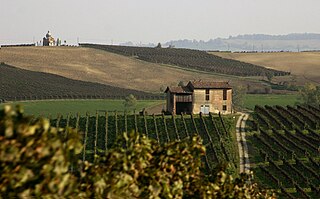
The Colli Piacentini are an Italian wine region located at the western end of Emilia-Romagna. In 1967, the region was given the denominazione di origine controllata (DOC) quality designation. Within its boundaries are several smaller DOCs including Colli Piacentini Gutturnio, Monterosso Val D'Arda DOC, Trebbianino Val Trebbia DOC, and Val Nur del Colli Piacentini DOC. The region has a long history of winemaking with fossilized vine roots and grape seeds excavated from the region showing viticulture taking place as early as 2000 BC. In Roman times, Julius Caesar's father-in-law Lucius Calpurnius Piso Caesoninus, grew grapes in the Piacenza hills.
Bombino nero is a red Italian wine grape variety that is grown in southern Italy, particularly the regions of Apulia, Basilicata, and Lazio, as well as on the island of Sardinia. It is a permitted grape variety in the Denominazione di origine controllata (DOC) wines of Castel del Monte and Lizzano. The grape is primarily a blending grape but it can also be used as a varietal for red and rosé wines. Though DNA evidence has shown that Bombino nero is not a dark-berried color mutation of the similarly named Bombino bianco, ampelographers still believe that the two varieties are related in some way.

Abruzzo is an Italian wine region located in the mountainous central Italian region of Abruzzo along the Adriatic Sea. It is bordered by the Molise wine region to the south, Marche to the north and Lazio to the west. Abruzzo's rugged terrain, 65% of which is mountainous, help to isolate the region from the winemaking influence of the ancient Romans and Etruscans in Tuscany but the area has had a long history of wine production.
Abbuoto is a red Italian wine grape variety that is grown primarily in the Lazio region of central Italy. Historically the grape was believed to be responsible for the Ancient Roman wine Caecubum that was praised by writers such as Pliny the Elder and Horace but historians and wine experts such as Jancis Robinson and Julia Harding note that connection is likely erroneous.
